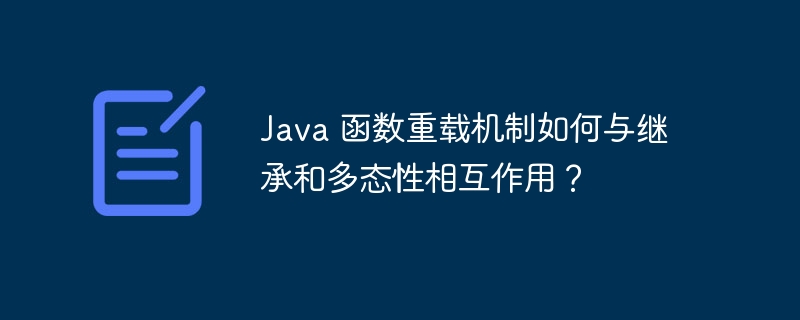
Function overloading allows subclasses to provide specific implementations of parent class methods through overriding, while inheritance and polymorphism enable subclass objects to be treated as parent class objects and call overridden methods. This interaction allows subclasses to provide function implementations customized to their needs while maintaining consistency with the parent class's interface.

Interaction between Java function overloading mechanism and inheritance and polymorphism
Function overloading
Function overloading allows the creation of multiple methods with the same name but different parameter lists in the same class.
Example:
class Shape { double area() { throw new AbstractMethodError(); } } class Rectangle extends Shape { double length, width; double area() { return length * width; } }
In this example, thearea()method inShapeis declared as abstract, indicating that Methods need to be implemented in subclasses. TheRectangleclass overloads thearea()method in the parent class and implements it using a rectangle-specific calculation method.
Inheritance
A subclass inherits methods and other members from its parent class.
Example:
class Animal { void makeNoise() { System.out.println("Animal noise"); } } class Dog extends Animal { @Override void makeNoise() { System.out.println("Woof woof"); } }
In this example, theDogclass inheritsmakeNoise() from theAnimalclassmethod and overridden it via the@Overrideannotation to provide a dog-specific implementation.
Polymorphism
Polymorphism allows a child class object to be treated as its parent class object and can call the same methods as the parent class object.
Example:
Animal animal = new Dog(); animal.makeNoise(); // 输出 "Woof woof"
In this example, although theanimalvariable is declared asAnimaltype, since it isDogobject, so the overridden implementation is triggered when themakeNoise()method is called.
Interaction of function overloading, inheritance and polymorphism
In the case of inheritance and polymorphism, function overloading allows subclasses to provide services specific to their needs The function implementation of the same name as the parent class. When a method is called from a subclass object, the overridden function implementation is called.
Practical case:
Consider an application that deals with geometric shapes. To calculate the area of individual shapes, you can use the following class hierarchy:
abstract class Shape { abstract double area(); } class Rectangle extends Shape { double length, width; @Override double area() { return length * width; } } class Circle extends Shape { double radius; @Override double area() { return Math.PI * radius * radius; } }
Through function overloading, theRectangleandCircleclasses can provide calculation of the area for their specific shapes Thearea()method is implemented. Polymorphism allows applications to handle different types of shapes and calculate their areas in a consistent manner.
The above is the detailed content of How does the Java function overloading mechanism interact with inheritance and polymorphism?. For more information, please follow other related articles on the PHP Chinese website!
